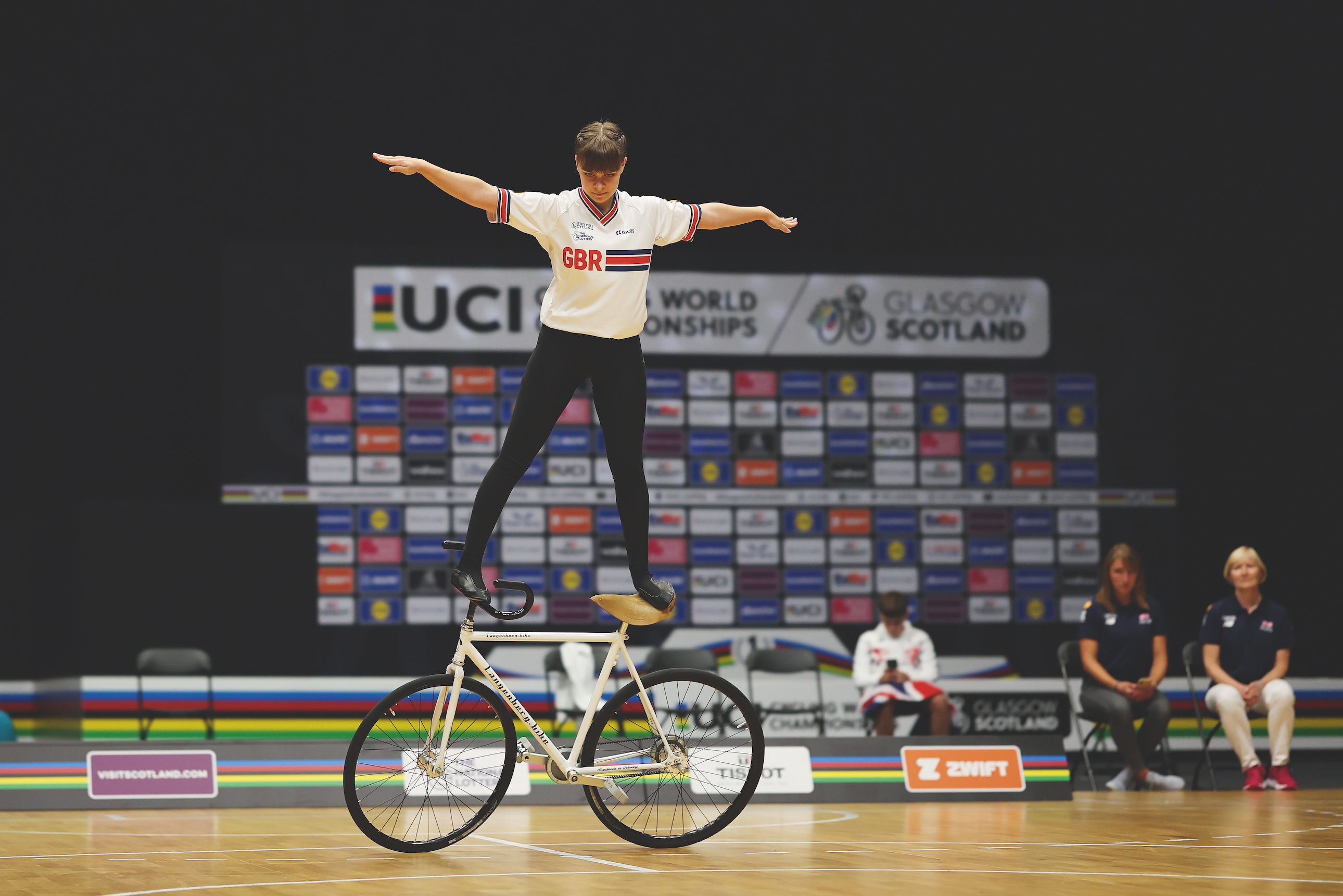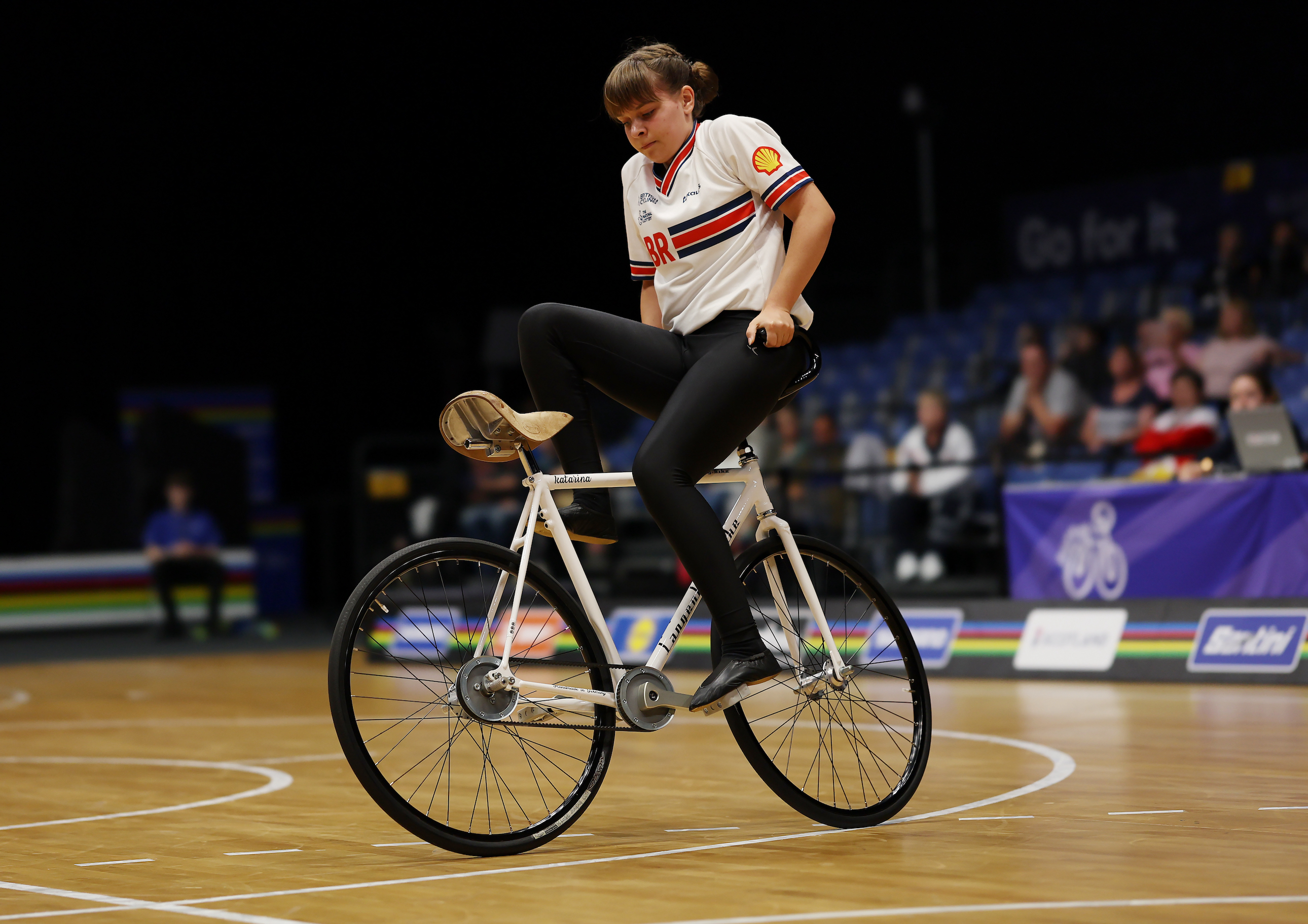
For each article in this long-running WATT WORKS FOR ME series from Cycling Weekly's print edition, we ask a pro rider about their favourite things in training: what has helped them most in getting to where they are today. The aim is to get to the heart of the beliefs and preferences they hold dear when it comes to building form, maximising fitness and ultimately achieving results. For this edition, we speak to artistic cyclist Katarina Howe.
Forgive our ignorance, but how does someone get into artistic cycling?
When I was younger, I started doing gymnastics and coincidentally my coach was doing artistic cycling in my club [SF Klado, Berlin – Howe’s mother is German and the family relocated to Germany in 2008]. It was through her that I got into artistic cycling – she simply asked me to try it one day, and I stuck with it.
What are you first and foremost, a cyclist or a gymnast?
To be honest, I can’t really decide. On the one hand, clearly, the bike is an important part of artistic cycling, so obviously a cyclist. On the other hand, the way we train and the tricks we do are more similar to gymnastics.
The sport seems to have a particularly strong following in Germany?
Yes, as the World Championships in Glasgow showed, Germany is the leading nation when it comes to artistic cycling and cycle-ball. I believe Germany has the most clubs doing [these disciplines], so it’s a big achievement to compete in international competitions for Germany – qualification alone is difficult for the athletes. [According to British Cycling, there is currently no recognised pathway into the sport in the UK.]
Talk us through the basics of artistic cycling.
Artistic cycling is similar to other disciplines in gymnastics, with points awarded by judges. Each element and trick is worth a set number of points. Athletes put together a routine of up to five minutes and 30 different elements. Of course, the more difficult the trick, the more points are awarded for it. Points are deducted for falls, wrong executions or other mistakes. The one with the most points in the end wins.
What does the training involve?
I usually train two hours at a time, three to four times a week indoors on the bike, plus regular strength and stretching exercises. I’m still in school, so it’s all about fitting it around that.
Which elements take the longest to learn or develop?
Obviously, every athlete has a trick that is particularly difficult for them depending on their level so it’s hard to really name one thing. Most would probably say the Maute Jump where you have to jump from the saddle to the handlebars because it takes a long time to learn. The various handstands can be hard to accomplish as well.
What do you love about the sport?
I love the difficulty and challenge of it. When talking about competitions I like that even though everybody is competing against each other it’s still like one big family. Even between the different nations, there is a lot of support and help, which is rare in other sports but often distinguishes smaller sports like ours.
How did the Worlds in Glasgow go for you?
I’m happy about my performance, bearing in mind it was my first World Championships. Not only did I enjoy the competition itself, but I was also glad to meet the other athletes.
Can a rider turn professional in artistic cycling?
Unfortunately not – it’s nearly impossible to live off income from artistic cycling. There are some athletes who after retiring from competitive cycling join certain [entertainment] shows or similar and go on tour but it’s hard to have that as your only income.
Do you aim to pursue the sport after school?
Yes, I want to continue as long as possible and as long as I have the time. With some of my older teammates, I see how challenging it can be to combine work/studying with training but I hope I’ll find a way to do so. I also hope that no injuries or other things will stop me from doing the sport.
Have you ever used your skills as a ‘party trick’?
Not really, because artistic cycling is made for the indoors! As a club, we have shown some of our tricks in choreographies for various shows. For example, in 2020 we performed in Feuerwerk der Turnkunst (Fireworks of Gymnastics) which is a German gymnastics show that goes on tour each year. Every stop they have a local club that is included in the show and we were chosen to perform in Berlin.
Rider profile: Katarina Howe
Age: 17
Height: 5ft 5in
Raised: London
Lives: Berlin, Germany
Best results: 7th, Indoor Cycling Junior European Championships (2023)

How are the bikes adapted?
The bikes have a one-to-one [fixed, single-speed] chain transmission to go forwards and backwards easily. We also have specially adapted handlebars and saddles that are adjustable to the height and preferences of the athlete.
If you were to try another cycling discipline, what would it be?
Definitely cycle-ball [football on bikes] because it is an interesting sport. I’ve already tried it once and it’s actually much more difficult and complex than it seems, so I would like the challenge.
Quick-fire faves
Event to compete in? European or World Championships
Artistic cycling trick? Either the shoulder stand – like a headstand, but with shoulders on the crossbar – or one of the handlebar stands.
Inspirational cyclist? Viola Brand (German artistic cyclist)
Favourite celebration meal? Pizza
Hardest part of artistic cycling? Learning new tricks
Favourite part of cycling? The competitions
Hobby or interest outside of sport? Listening to music
The full version of this article was published in the 7 September 2023 print edition of Cycling Weekly magazine. Subscribe online and get the magazine delivered to your door every week.







